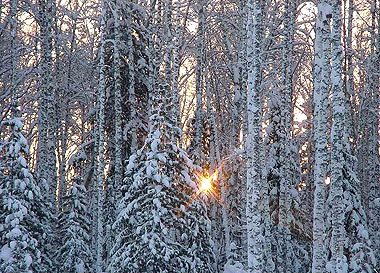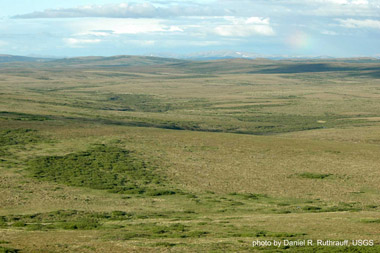Tundra in the Western Andreafsky Wilderness of Alaska (U.S.)
Click on image for full size
USGS - Daniel R. Ruthrauff, photographer
Tundra Biome
In the very cold places of the world, survival isn't easy. The soil is frozen, its top surface thawing only during summer, and no trees can grow. Yet plants and animals that are adapted for the harsh conditions thrive. This biome is called tundra. Most of the world's tundra is found in the Arctic. It is called Arctic tundra. There is a small amount of tundra on parts of Antarctica that are not covered with ice. Plus, tundra is found on high altitude mountains and is called alpine tundra.
Permafrost is the term given to frozen soil. During the winter months, permafrost
reaches the surface of the tundra. It is very cold during the winter, with temperatures reaching
-60 degrees Fahrenheit (-51 degrees Celsius). Very few animals are active in these harsh conditions.
In the summer time, the tundra changes. The Sun is out almost 24 hours a day, so the tundra starts to warm up.
The permafrost melts at the surface, and plant life grows. However, the permafrost only disappears for a few inches below the surface. There isn't
enough soil for trees to grow, so only small plants are found in the tundra.
At the same time, a variety of animals come out to feast on the plants. Insects come to feed on the animals, and birds
appear to enjoy the insects.
Last modified October 24, 2008 by Lisa Gardiner.
You might also be interested in:

North of the Arctic Circle (at 66.5°N latitude) you will find the Arctic Ocean surrounded by the northernmost parts of the continents of Europe, Asia, and North America. You will find the geographic North
...more
The Arctic tundra, vast plains filled with grasses, flowers, mosses and lichen, is located north of the taiga forests in Earth’s north polar region. Like all types of tundra, this is a very cold and windy
...more
Antarctica is unique. It is the coldest, windiest, and driest continent on Earth. The land is barren and mostly covered with a thick sheet of ice. Antarctica is almost entirely south of the Antarctic Circle
...more
There are so many interesting mammals in the tundra, they had to be divided into two groups! You can read about carnivores here. Musk-ox and caribou are the largest herbivores in the tundra region. Both
...more
Biomes are large regions of the world with similar plants, animals, and other living things that are adapted to the climate and other conditions. Explore the links below to learn more about some of the
...more
“Taiga” is a Russian word meaning dense evergreen forest. The taiga biome, the largest biome on land, is full of dense evergreen forests. Located just south of the tundra in the northern parts of Europe,
...more
Latitude determines the amount of sunlight received. The amount of sunlight and the amount of moisture received determines the ecosystem or biome. Listed below are the types of ecosystems that exist in
...more















